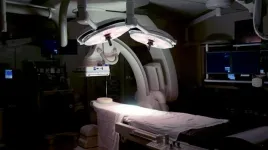(Press-News.org) April 19, 2021 - An estimated 50 million people undergo surgery each year in the United States, and a significant proportion of them have undiagnosed or untreated sleep disorders (SD) or sleep-disordered breathing (SDB). Issues at the intersection of anesthesiology and sleep medicine are the focus of the Society of Anesthesia and Sleep Medicine (SASM) whose 10th anniversary is commemorated in the special theme May issue of Anesthesia & Analgesia.
The special issue looks back at a remarkable first decade of achievements in research and clinical practice by this young subspecialty society, while looking forward to further progress. A key focus is the potential for treating surgery and the perioperative period as an opportunity for recognition, diagnosis and effective treatment of patients with undiagnosed SD or SDB, according to an editorial by Satya Krishna Ramachandran, MD, Associate Professor of Anaesthesia at Harvard Medical School and President of SASM.
New insights on sleep apnea surgery, postoperative respiratory depression and more
The SASM theme issue presents 15 papers on key issues related to anesthesia and surgical management of patients with SD or SDB. Eric Brian Rosero, MD, MSc, and Girish P. Joshi, MBBS, MD, of University of Texas Southwestern Medical Center, Dallas, analyzed the outcomes of 3,208 patients undergoing sleep apnea surgery.
The study focused on complications and other outcomes for patients undergoing inpatient versus outpatient surgery. About two-thirds of patients had inpatient surgery, spending at least one night in the hospital. On initial analysis, the inpatient surgery group had a higher rate of hospital readmissions, repeat surgery, and complications: 6.8 versus 5.5 percent.
However, on further analysis of patients with similar risk factors (age, health conditions, etc.), the rate of adverse outcomes was almost identical for the inpatient and outpatient groups: 6.2 versus 5.9 percent. Certain factors were associated with a higher rate of adverse events, including diabetes and more complex surgery. "These risk factors could be used to determine the need for an overnight stay," Drs. Rosero and Joshi conclude.
A study led by Toby N. Weingarten, MD, of the Mayo Clinic, Rochester, Minn., used data from a previous study of patients undergoing continuous bedside monitoring after surgery to assess the occurrence of episodes of postoperative respiratory depression (RD). While postoperative RD events were once considered uncommon, recent studies suggest that they may occur in more than 40 percent of patients and often go unrecognized.
From the total of 250 patients, the researchers identified 155 patients with a total of more than 2,500 RD episodes within the first 24 hours after surgery. Initial RD episodes tended to occur within the first several hours after surgery. These initial episodes peaked in the late afternoon and early evening, often followed by repeated episodes during the early morning hours.
The rate and frequency of postoperative RD episodes were greater for patients who scored higher on a risk scale used in the original study. Dr. Weingarten and colleagues believe their unique data may have important implications for research and clinical practice, including the development of new postoperative monitoring strategies.
In his editorial, Dr. Ramachandran focuses on strategies to promote diagnosis and treatment of unrecognized sleep disorders in patients undergoing anesthesia and surgery. He writes, "If we in anesthesiology are indeed committed towards the fundamental tenets of perioperative medicine, the import of using the perioperative period to diagnose and initiate long-term medical care of SD or SDB cannot be overstated."
Assembled by invitation from the editors of Anesthesia & Analgesia, the SASM theme issue celebrates "a decade of research achievements in the common ground between sleep and anesthesia," according to an introductory editorial by Dr. Weingarten and his fellow guest editors. They add: "Among other things, these studies build the case for greater awareness of sleep issues among anesthesiologists and enhanced sleep training in anesthesia."
INFORMATION:
Click here to read "Frequency and Temporal Distribution of Postoperative Respiratory Depressive Events."
DOI: 10.1213/ANE.0000000000005478
Anesthesia & Analgesia is published by Wolters Kluwer.
View the article collection from Anesthesia & Analgesia.
About Anesthesia & Analgesia
Anesthesia & Analgesia was founded in 1922 and was issued bi-monthly until 1980, when it became a monthly publication. A&A is the leading journal for anesthesia clinicians and researchers and includes more than 500 articles annually in all areas related to anesthesia and analgesia, such as cardiovascular anesthesiology, patient safety, anesthetic pharmacology, and pain management. The journal is published on behalf of the IARS by Lippincott Williams & Wilkins (LWW), a division of Wolters Kluwer, Health.
About the IARS
The International Anesthesia Research Society is a nonpolitical, not-for-profit medical society founded in 1922 to advance and support scientific research and education related to anesthesia, and to improve patient care through basic research. The IARS contributes nearly $1 million annually to fund anesthesia research; provides a forum for anesthesiology leaders to share information and ideas; maintains a worldwide membership of more than 15,000 physicians, physician residents, and others with doctoral degrees, as well as health professionals in anesthesia related practice; sponsors the SmartTots initiative in partnership with the FDA; supports the resident education initiative OpenAnesthesia; and publishes two journals, Anesthesia & Analgesia and A&A Case Reports.
About Wolters Kluwer
Wolters Kluwer (WKL) is a global leader in professional information, software solutions, and services for the clinicians, nurses, accountants, lawyers, and tax, finance, audit, risk, compliance, and regulatory sectors. We help our customers make critical decisions every day by providing expert solutions that combine deep domain knowledge with advanced technology and services.
Wolters Kluwer reported 2020 annual revenues of €4.6 billion. The group serves customers in over 180 countries, maintains operations in over 40 countries, and employs approximately 19,200 people worldwide. The company is headquartered in Alphen aan den Rijn, the Netherlands.
Wolters Kluwer provides trusted clinical technology and evidence-based solutions that engage clinicians, patients, researchers and students in effective decision-making and outcomes across healthcare. We support clinical effectiveness, learning and research, clinical surveillance and compliance, as well as data solutions. For more information about our solutions, visit https://www.wolterskluwer.com/en/health and follow us on LinkedIn and Twitter @WKHealth.
For more information, visit http://www.wolterskluwer.com, follow us on Twitter, Facebook, LinkedIn, and YouTube.
More blood thinners aren't automatically better, another study confirms.
A new publication in JAMA Internal Medicine focuses on the minimal pros and the concerning cons of combining a daily aspirin with a drug from the newer class of anticoagulants that include apixaban, dabigatran, edoxaban and rivaroxaban.
Patients were taking one of these direct oral anticoagulants known as DOACs to prevent strokes from non-valvular atrial fibrillation or for the treatment of venous thromboembolic disease (deep vein thrombosis or pulmonary embolism). The included patients did not have another reason to take aspirin ...
PHILADELPHIA - A new gene therapy for one of the most common forms of congenital blindness was safe and improved patients' vision, according to initial data from a clinical trial led by researchers at the Scheie Eye Institute in the Perelman School of Medicine at the University of Pennsylvania.
The therapy delivers working copies of GUCY2D to the eyes of patients who have severe vision impairments caused by mutations in the gene. Each of the first three treated patients experienced improvement in some aspects of vision, without serious side effects, according to the new study, published in the journal iScience.
"We found sustained improvements in both day and night vision, even with a relatively low dose of the gene therapy," said study lead author Samuel G. Jacobson, MD, ...
A new study outlines the need for materials advances in the hardware that goes into making quantum computers if these futuristic devices are to surpass the abilities of the computers we use today.
The study, published in the journal Science by an international team, surveyed the state of research on quantum computing hardware with the goal of illustrating the challenges and opportunities facing scientists and engineers.
While conventional computers encode "bits" of information as ones and zeroes, quantum computers breeze past this binary arrangement by creating "qubits," which can be complex, continuous quantities. Storing and manipulating information ...
JACKSONVILLE, Fla. -- In a new paper published in Nature Communications, Mayo Clinic researchers and collaborators report the protein-coding gene SERPINA5 may worsen tau protein tangles, which are characteristic of Alzheimer's disease, and advance disease. By combining clinical expertise, brain tissue samples, pathology expertise and artificial intelligence, the team clarified and validated the relevance of the gene to Alzheimer's disease.
The researchers used tissue samples from 385 brains donated to the Mayo Clinic Brain Bank, which houses more than 9,000 brain tissue specimens for the study of neurodegenerative disorders. The samples were from people who were diagnosed with Alzheimer's disease and lacked co-existing diseases found in ...
Hydrogen will be needed in large quantities as an energy carrier and raw material in the energy system of the future. To achieve this, however, hydrogen must be produced in a climate-neutral way, for example through so-called photoelectrolysis, by using sunlight to split water into hydrogen and oxygen. As photoelectrodes, semiconducting materials are needed that convert sunlight into electricity and remain stable in water. Metal oxides are among the best candidates for stable and inexpensive photoelectrodes. Some of these metal oxides also have catalytically active surfaces that accelerate the formation of hydrogen at the cathode or oxygen at the anode.
Why is rust not much better?
Research has long focused on haematite (α-Fe2O3), ...
MINNEAPOLIS - April 19, 2021 - Despite access to some of the best possible medical care in the world, Senators John McCain and Edward Kennedy both died within 18 months of their diagnosis of glioblastoma, an aggressive form of brain cancer. While this deadly outcome typifies the nature of this disease, some glioblastoma patients see exceptional benefits from chemotherapy and survive beyond expectations. Why this happens has been revealed by researchers at the University of Minnesota in a new study published in the Proceedings of the National Academy of Sciences.
"Deciphering the molecular underpinning of these exceptional ...
In March 2020, when the pandemic hit, everything slowed, including non-essential medical procedures such as elective surgeries, to reduce the spread of the coronavirus.
Six weeks later, Mary Byrnes, Ph.D., an assistant research scientist in the Department of Surgery at Michigan Medicine, began calling University of Michigan Frankel Cardiovascular Center patients whose surgeries had been canceled or delayed. She wanted to hear about their experiences -- what undergoing surgery meant to them, how postponing their operations had affected them, whether the existence of the coronavirus complicated how they felt about their bodies and ...
Psoriasis is a common inflammatory skin condition. The underlying genetic factors have not yet been sufficiently researched. The skin inflammation is usually triggered by external factors such as infections or stress. A research team at the Institute of Cancer Research of the Medical University of Vienna has now managed to identify a new factor in signal transmission of the immune system that plays a major role in the development of a psoriatic episode. The scientists have shown that symptoms can be alleviated by inhibiting the "c-Jun" protein in signal transmission.
The common clinical manifestation of psoriasis is a pinkish-grey thickening of the epidermis in distinct foci of infection, ...
It has been known for about a year that minks can become infected with SARS-CoV-2. The virus had been transmitted from humans to farmed mink and mutated in infected animals. Mutations were acquired in the spike protein, which is crucial for the entry of the virus into host cells and represents the central point of attack for antibodies. These SARS-CoV-2 variants from mink were transmitted back to humans, raising concerns that minks could be a continuing source of infection of humans with SARS-CoV-2 variants with altered biological properties. Researchers at the German Primate Center (DPZ) - Leibniz Institute for Primate Research in Göttingen, Germany, have now shown that an antibody used for COVID-19 ...
A simple dietary supplement reduces behavioral symptoms in mice with a genetic mutation that causes schizophrenia. After additional experiments, including visualizing the fluorescently stained dancing edge of immature brain cells, researchers concluded that the supplement likely protects proteins that build neurons' cellular skeletons.
The supplement betaine was first isolated from sugar beets and is often associated with sweetness or umami flavor. Healthy levels of betaine come from both external food sources and internal synthesis in the body. Betaine ...


